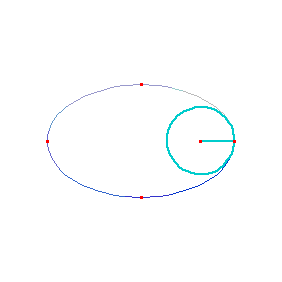Curvature
Description
Curvature is a value that measures how curved is the curve at a point on a curve. The most intuitive way to see it is that at any point P on the curve there is a circle of right size that touches P and fits the most. Call this most-fitting circle the osculating circle. The flatter the curve at P, the larger is its osculating circle. The sharper the curve at P, the smaller is its osculating circle. Thus, we can define the value of curvature as 1/r, where r is the radius of the osculating circle. When the osculating circle is large, the curve is flattish, and the curvature 1/r is small.

Ideally, a line would have curvature of 0 everywhere, and its osculating circle doesn't exist. (i.e. have infinite radius) A Circle of radius R would have a constant curvature of 1/R, and its osculating circle at any point on the circle would be the same as the circle itself.
There are several ways to define osculating circle mathematically. One way is by the limit of the intersetion of two normals at points P1 and P2 on the curve as P1 and P2 approach each other and meet at P. The limit of that intersection is the center C of a osculating circle at P. Thus, distance CP would be the radius of the osculating circle, and 1/distance[C,P] would be the curvature.
Another way to define curvature mathematically is the rate of change of the turning of the tangent line. That is, suppose θ is the angle of the tangent at P and the x-axis. As a P moves on the curve, θ changes. The curvature at P is the rate of change of θ at P. This way, see see that a line has curvature of 0 everywhere since it's tangent doesn't change. And a circle would have constant curvature because its tangent turns in a constant way.
Formula
Given a parametric curve {xf[t],yf[t]}, let T[t] be the unit-length tangent vector at t. That is, T[t]:={xf'[t]/,yf'[t]}/s[t],
where s[t] is the “speed” defined as s[t]:=Sqrt[xf'[t]^2 + yf'[t]^2]. Let N[t] be the unit-length normal at t, that is, let {t1[t],t2[t]} denoted the coordinates of T[t], then N[t]= {-t2[t],t1[t]}. Now, curvature can be given as:
k[t] := (T'[t] . N[t])/s[t]
Expand it out we have:
k = (x' y'' - x'' y')/(x'^2+y'^2)^(3/2)
(argument suffix [t] dropped for easy reading. xf[t] replaced by x, yf[t] by y.) Note: osculating circle is also called Osculating Circle.
Interesting Examples
Interesting curves involning the curvature concept, see:
- Evolute curve (the centers of osculating circles)
- Radial curve (locus of osculating circle normals)
- circle (constant curvature everywhere)
- line (curvature of 0 everywhere)
- Clothoid (spiral of linearly increasing curvature)
For a gallery of artifacts that involves fancy curves, see: Curlicues .